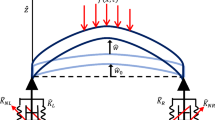Abstract
Based on continuous Hilbert space basis functions and mean square convergence properties of spatial generalised Fourier series a new technique for hybrid modal analysis (HMA) is proposed. The technique utilises a mix of experimental, measured vibration responses and good numerical approximations of well defined, three-dimensional, real, normal modes. The modes are assumed to be solutions to an elastic, eigenvalue problem corresponding to the true geometry of the analysed body or structure. Starting from a known geometry and a suitable set of modes, it is shown that the measured data may be supplemented with spatial information about the whole vibrational displacement field which is correctly represented by the chosen set of complete (Hilbert space), modal basis vector fields. The spatial information is extracted from the measured vibration responses by curve fitting a truncated modal response model to the data. As a result of the curve fit a number of generalised Fourier coefficient spectra are obtained which together with the corresponding modes may be used to predict or simulate responses which were not measured or used in the curve fit. Given also the true mass density field of the body, the time average of the kinetic energy of the whole body may be approximated using only a restricted set of measured vibration responses. The method is completely general and applicable in all cases where the vibrational displacements are small enough compared to the characteristic dimensions of the analysed body. The effect of modal truncation and means to approximate corresponding dynamic displacement residuals are discussed for linear, anisotropic solid bodies and structures with general damping. Modal coupling due to damping and unknown elastic properties are also discussed. The method has been tested, with very good results, on experimental data measured with a laser doppler vibrometer on a plexiglas plate excited with a shaker in the frequency range 25–500 Hz.
Similar content being viewed by others
Author information
Authors and Affiliations
Rights and permissions
About this article
Cite this article
Dovstam, K. Real modes of vibration and hybrid modal analysis. Computational Mechanics 21, 493–511 (1998). https://doi.org/10.1007/s004660050328
Issue Date:
DOI: https://doi.org/10.1007/s004660050328




